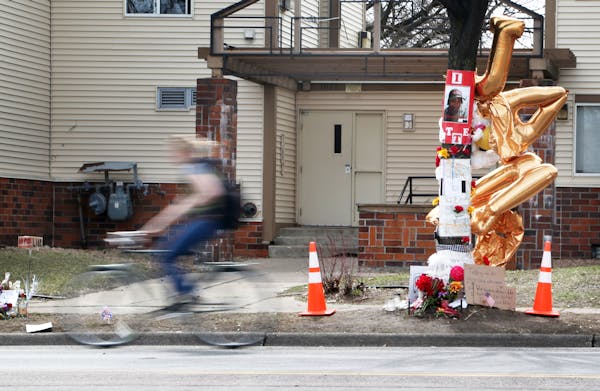How can multiple witnesses to the same scene see different things?
On the night Jamar Clark was fatally shot by police, some witnesses saw Clark handcuffed; others weren't sure. Whether Clark was cuffed became a key factor in the decision not to charge the two Minneapolis officers involved in the shooting.
Hennepin County Attorney Mike Freeman determined Clark was not handcuffed, based on forensic DNA evidence rather than eyewitnesses — in part, he said, because eyewitnesses contradicted one another.
It's not unusual to get conflicting eyewitness reports of a crime scene, especially such a traumatic and high-profile one.
Everything from sightlines and lighting conditions to whether witnesses spoke to one another or had access to media can affect how memories are formed, stored and recalled. Even the words investigators use when talking to witnesses may affect how memories solidify. The witnesses' personal biases also could weigh heavily on how they remember what they saw. And the more those memories are recalled, the more they can change.
"Memory is not a perfect video recording of one's reality," said Joe Vitriol, a University of Minnesota doctoral candidate whose research focuses on perception and judgment. "It's a reconstruction of information, of events, and it's subject to the kinds of information that we perceive and attend to."
It's not that witnesses are lying, said Elizabeth Loftus, a leading human memory researcher based at the University of California, Irvine. It's that memory is malleable.
The Clark case is "one in a long string of traumatic events involving police shootings where people have memories that are contradicted by physical evidence or inconsistent with other witnesses' recollections," she said. "Once you have an appreciation for the flexibility of memory, it's an explanation for how that kind of thing can happen in people who are being honest."
Change over time
It all starts in the cortex, the part of the brain that records the sight and sound of an experience. Those regions reactivate every time a person has a memory, so he or she is basically reliving the experience via the senses. With short-term memory, the hippocampus initiates those parts of the cortex to reactivate, until, eventually, the memory becomes permanent — burned into the brain, so to speak.
But memories, even long-lasting ones, are subject to inferences made by the brain or by outside influences, whether at the scene, a day or two later, during subsequent recollections or over time.
"The reason why people say eyewitness memory is so bad is that it can be contaminated," said John Wixted, a psychologist and memory researcher at the University of California, San Diego.
There are a number of reasons memories can get distorted, and the power of suggestion, intended or not, is a significant one. The way a police officer asks a question can have a lot to do with how a person remembers the scenario.
Something as simple as an investigator's nod or grunt of affirmation can bolster a witness' confidence in a memory. And a sense of confidence is an indicator of the accuracy of a memory. Advocates for eyewitness reform suggest having witnesses rate their confidence when giving their statements.
"What's often overlooked is that people know when they don't know," said Wixted. "I think there would be a lot less disagreement of eyewitness accounts if you knew how confident they were. It's so critical."
Because of the instability of memory, groups like the Minnesota Innocence Project are fighting to overturn wrongful convictions that hinged on eyewitness identification. Almost 68 percent of all DNA exonerations to date have to do with such cases, said executive director Heather Ring. "What that tells us is that [eyewitness memory] is unbelievably unreliable."
Laws in just a few states require juries to be informed about memory's shortcomings before hearing eyewitness testimony; there is no such law in Minnesota.
Minneapolis criminal defense attorney Joe Friedberg thinks there should be. At some trials, Friedberg tells juries a story to show the vulnerability of memory: A Minnesota Vikings fan and a Green Bay Packers fan are watching a game. They're both sitting on the goal line, and the Vikings have the ball.
"It's very close whether he gets into the end zone," Friedberg said. "The Viking fan will see and believe that he sees a touchdown. The Packer fan will see and believe that he sees no touchdown. And neither one of them are being dishonest."
"It's the difference between what you see and what you perceive. There is no such thing as an absolute in what people see."
Plus, a memory is affected by the events in which it was created.
"We know that stress and we know that trauma can undermine people's memory," said the U's Vitriol. "In a 60-second time frame, we see Jamar Clark engaged in confrontation and a violent exchange with law enforcement. That could be stressful for a lot of people, in particular for members of communities who lack trust and confidence in the criminal justice [system].
"It's really important for people to understand that witnesses may reach different kinds of understandings of the same incident," Vitriol said. "This doesn't reflect malintent, this doesn't reflect neglect, it doesn't reflect anything other than the basic fundamental way we in which we encode memory."
Sharyn Jackson • 612-673-4853
@SharynJackson

Former diversity worker sues University of Minnesota after firing over swastika photo

As longtime Hutchinson, Litchfield papers close, 2 newspapers launch to take their place

In Grand Rapids, Itasca Pride is planning its first event, but there is already pushback
Mother charged with fentanyl overdose death of her 8-month-old boy in Roseville hotel room

